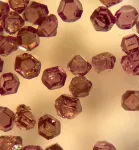(Press-News.org) Cultural diversity -- indicated by linguistic diversity -- and biodiversity are linked, and their connection may be another way to preserve both natural environments and Indigenous populations in Africa and perhaps worldwide, according to an international team of researchers.
"The punchline is, that if you are interested in conserving biological diversity, excluding the Indigenous people who likely helped create that diversity in the first place may be a really bad idea," said Larry Gorenflo, professor of landscape architecture, geography and African studies, Penn State. "Humans are part of ecosystems and I hope this study will usher in a more committed effort to engage Indigenous people in conserving localities containing key biodiversity."
Gorenflo, working with linguist Suzanne Romaine, Merton College, University of Oxford, UK, looked at 48 localities in Africa designated by the United Nations Education, Scientific and Cultural Organization (UNESCO) as Natural World Heritage Sites. These sites host "globally important natural or combined natural and cultural resources," they report. This paper was placed online as an unedited manuscript in January 2021 ahead of final online publication in April 2021 in Conservation Biology.
They analyzed geographic information system data on Indigenous languages in these areas and found that 147 languages overlapped with the UNESCO sites. Indigenous languages occurred in all but one of the Natural World Heritage Sites examined.
"The Namib Sand Sea desert in Namibia is a pretty dry area," said Gorenflo. "Kind of desolate, with wonderful sand dunes and natural features, but so harsh that there is no one living there as far as I know."
But in all the other Natural World Heritage Sites in continental Africa and on nearby islands, Indigenous people not only live, but, to some extent, manage the environment in which they live and have been doing so for a long time.
"The big message is basically that there is increasing evidence that cultural diversity and biodiversity are interrelated, and we found this at a fairly fine geographic scale," said Gorenflo. "If this is the case, then it makes a strong argument for Indigenous people to be part of ecosystem management in sites where they live.
"In terms of management approach, when there is more than one linguistic group associated with a specific site, the strategy probably should be to let the people associated with individual areas deal with those areas," he said.
In addition to finding that speakers of Indigenous languages often live in high-profile UNESCO sites, the researchers also found that the number of languages in these localities correlated with the number of species whose ranges of occurrence include these sites.
For their language data, the team used Ethnologue, a linguistic database originally established to translate the bible and the only global dataset for languages with detailed geographic information.
"The database is certainly not totally correct," said Gorenflo. "But it does show major patterns."
For the species data, the researchers used the International Union for Conservation of Nature's Red List of Endangered Species which includes species range data. They looked at amphibians, mammals, reptiles and a collection of freshwater species. They also used data from Birdlife International and "Handbook of the Birds of the World" for bird species.
"What we found numerically is that within UNESCO World Heritage Sites, if you plot language numbers against species range numbers, you find that there is a positive relationship," said Gorenflo. "It may be because more natural complexity generates more cultural complexity, though we do not know for sure."
Study results revealed that in the UNESCO sties in Africa, Indigenous languages overlapped with the ranges of more than 8,200 species in the groups considered.
Gorenflo suggests that there might be a reduction in biodiversity in these globally important African sites if Indigenous groups are displaced or somehow have their influence on managing these localities marginalized.
"Our ultimate goal is to try to look at a few places and figure out how we might redesign and reconsider management strategies and get Indigenous people more involved in shared governance."
Focusing on these high-profile UNESCO sites provides a basis for engaging Indigenous people in governance that hopefully will extend to less noteworthy places in Africa and beyond, according to Gorenflo.
He hopes to examine specific areas to increase their understanding of the relationship between biological and linguistic diversity, focusing first on the Eastern Arc Mountains of Tanzania where much of the linguistic and biological diversity occur in this nation. He also plans to examine Vanuatu, an archipelago in the eastern Melanesian Islands Biodiversity Hotspot with particularly dense linguistic diversity. Two other biodiversity hotspots of interest are Indo-Burma -- Cambodia, Lao, Viet Nam, Myanmar and Southern China -- and Mesoamerica, two regions where linguistic diversity is also quite high.
INFORMATION:
Indigenous people have lived in the Bears Ears region of southeastern Utah for millennia. Ancestral Pueblos built elaborate houses, check dams, agricultural terraces and other modifications of the landscape, leaving ecological legacies that persist to this day. Identifying how humans interacted with past environments is critical for informing how best to protect archaeological sites and ecological diversity in the present. This "archaeo-ecosystem" approach would facilitate co-management of public lands in ways that promote Indigenous health, cultural reclamation and sovereignty.
For the first time, a new study evaluated ecological legacies, archaeo-ecosystem restoration and Indigenous ...
There are roughly 50 billion individual birds in the world, a new big data study by UNSW Sydney suggests - about six birds for every human on the planet.
The study - which bases its findings on citizen science observations and detailed algorithms - estimates how many birds belong to 9700 different bird species, including flightless birds like emus and penguins.
It found many iconic Australian birds are numbered in the millions, like the Rainbow Lorikeet (19 million), Sulphur-crested Cockatoo (10 million) and Laughing Kookaburra (3.4 million). But other natives, like the rare Black-breasted Buttonquail, only have around 100 members left.
The findings are being published this week in the Proceedings ...
Scientists studying the impact of record heat and drought on intact African tropical rainforests were surprised by how resilient they were to the extreme conditions during the last major El Niño event.
The international study, reported in Proceedings of the National Academy of Sciences today, found that intact rainforests across tropical Africa continued to remove carbon from the atmosphere before and during the 2015-2016 El Niño, despite the extreme heat and drought.
Tracking trees in 100 different tropical rainforests across six African countries, the researchers found that intact forests across the continent still removed 1.1 billion tonnes of carbon dioxide per year from the atmosphere during the El Niño monitoring ...
Researchers at Baylor College of Medicine have followed the progression of breast cancer in an animal model and discovered a path that transforms a slow-growing type of cancer known as estrogen receptor (ER)+/HER2+ into a fast-growing ER-/HER2+ type that aggressively spreads or metastasizes to other organs.
The study, which appears in the Proceedings of the National Academy of Sciences, has implications for breast cancer therapy as it suggests the need to differentiate cancer subtypes according to the path the cells follow. Different paths might be linked to different cancer behavior, which should be taken into consideration to plan treatment appropriately.
"In ...
Scientists have detected new early-warning signals indicating that the central-western part of the Greenland Ice Sheet may undergo a critical transition relatively soon. Because of rising temperatures, a new study by researchers from Germany and Norway shows, the destabilization of the ice sheet has begun and the process of melting may escalate already at limited warming levels. A tipping of the ice sheet would substantially increase long-term global sea level rise.
"We have found evidence that the central-western part of the Greenland ice sheet has been destabilizing and is now close to a critical transition," explains lead author Niklas ...
A new technology developed by UZH researchers enables the body to produce therapeutic agents on demand at the exact location where they are needed. The innovation could reduce the side effects of cancer therapy and may hold the solution to better delivery of Covid-related therapies directly to the lungs.
Scientists at the University of Zurich have modified a common respiratory virus, called adenovirus, to act like a Trojan horse to deliver genes for cancer therapeutics directly into tumor cells. Unlike chemotherapy or radiotherapy, this approach does no harm to normal healthy cells. Once inside tumor cells, the delivered genes serve as a blueprint for therapeutic ...
When doctors or scientists want to peer into living tissue, there's always a trade-off between how deep they can probe and how clear a picture they can get.
With light microscopes, researchers can see submicron-resolution structures inside cells or tissue, but only as deep as the millimeter or so that light can penetrate without scattering. Magnetic resonance imaging (MRI) uses radio frequencies that can reach everywhere in the body, but the technique provides low resolution -- about a millimeter, or 1,000 times worse than light.
A University of California, Berkeley, researcher has now shown that microscopic ...
PHILADELPHIA and MELBOURNE, Australia -- (May. 17, 2021) -- A team of scientists from The Wistar Institute in Philadelphia and the Peter MacCallum Cancer Center in Melbourne, Australia, discovered a new checkpoint mechanism that fine-tunes gene transcription. As reported in a study published in Cell, a component of the Integrator protein complex tethers the protein phosphatase 2A (PP2A) to the site of transcription allowing it to stop the activity of the RNA polymerase II enzyme (RNAPII). Disruption of this mechanism leads to unrestricted gene transcription and is implicated in cancer.
The study points to new viable opportunities for therapeutic ...
Exposure to light is compulsory for photosynthetic organisms for the conversion of inorganic compounds into organic ones. However, if there is too much solar energy, the photosystems and other cell components could be damaged. Thanks to special protective proteins, the overexcitation is converted into heat - in the process called non-photochemical quenching. The object of the published study, OCP, was one of such defenders. It was first isolated in 1981 from representatives of the ancient group of photosynthetic bacteria, ?yanobacteria. OCP comprises two domains forming a cavity, in which a carotenoid pigment is embedded.
"When light is absorbed by the carotenoid molecule, OCP can change from an inactive orange to an active red form. ...
For much of the nation's food supply, removing unsafe products off of store shelves can take up to 10 months, according to news reports -- even when people are getting sick.
The growing complexity and scope of modern supply chains result in painfully slow product recalls, even when consumer well-being is at stake. For example, in 2009, salmonella-tainted peanuts killed nine people and sickened more than 700 in 46 states, and the resulting nationwide recall cost peanut farmers, their wholesale customers and retailers more than $1 billion in lost production ...






